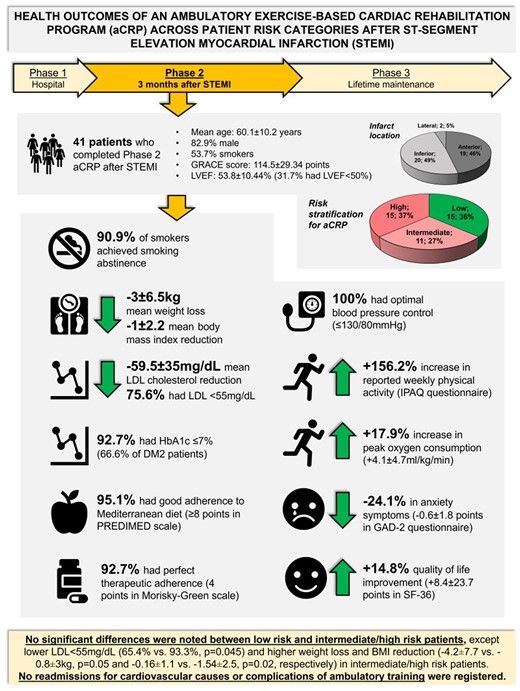-
PDF
- Split View
-
Views
-
Cite
Cite
V Marcos Garces, H Merenciano-Gonzalez, M L Martinez Mas, P Palau, J I Climent Alberola, N Perez, L Lopez-Bueno, M C Esteban Argente, M Valls Reig, R Munoz Alcover, I Pradillas Contreras, A Arizon Benito, A Paya Rubio, F J Chorro, V Bodi, Health outcomes of an ambulatory exercise-based cardiac rehabilitation program across patient risk categories, European Heart Journal, Volume 44, Issue Supplement_2, November 2023, ehad655.2599, https://doi.org/10.1093/eurheartj/ehad655.2599
Close - Share Icon Share
Abstract
Exercise-based cardiac rehabilitation is recommended after an ST-segment elevation myocardial infarction (STEMI) to improve prognosis, quality of life and control of cardiovascular risk factors. Ambulatory training has been proposed as an alternative if in-hospital training is unavailable.
To study the health outcomes of an ambulatory exercise-based Cardiac Rehabilitation Program (aCRP) in STEMI patients across different patient risk profiles.
A Phase 2 aCRP aimed to STEMI patients was implemented in our hospital in 2022. Conventional or cardiopulmonary exercise testing (C/CPET) was performed, patient risk was stratified as low risk or intermediate/high risk, and a 3-month, individualized aerobic and strength ambulatory training program was provided. C/CPET was repeated at the end of Phase 2 and peak oxygen consumption (peak VO2) was measured. Questionnaires were used to analyse quality of life (SF-36), depression (PHQ-2), anxiety (GAD-2), adherence to Mediterranean diet (PREDIMED) and weekly physical activity (IPAQ). Comparisons were performed between patients at low risk and patients at intermediate/high risk. A p<0.05 was considered statistically significant.
The cohort comprised 41 patients who completed Phase 2 of aCRP (mean age 60.1±10.2 years, 82.9% male and 53.7% smokers) and were stratified as low risk (n=15, 36.6%) or intermediate/high risk (n=26, 63.4%). Reductions in systolic blood pressure (-7.9±15.7mmHg), LDL cholesterol (-59.5±35mg/dL), weight (-3±6.5kg) and body mass index (BMI, -1±2.2) were attained (all p<0.05). Smoking abstinence was accomplished in 90.9% of smokers and most patients achieved an LDL<55mg/dL target (75.6%). Quality of life improved (+8.4±23.7 points in SF-36, p=0.03) and anxiety symptoms diminished (-0.6±1.8 points in GAD2, p=0.04). A median 4.1±4.7ml/kg/min peak VO2 increase was achieved (+17.9% from baseline, p<0.001) and patients increased their reported weekly physical activity in 2681.1±3385.3 METS/week (+156.2% from baseline, p<0.001). No significant differences were noted between low risk and intermediate/high risk patients, except lower LDL<55mg/dL (65.4% vs. 93.3%, p=0.045) and higher weight loss and BMI reduction (-4.2±7.7 vs. -0.8±3kg, p=0.05 and -0.16±1.1 vs. -1.54±2.5, p=0.02, respectively) in intermediate/high risk patients. No readmissions for cardiovascular causes or complications of ambulatory training were registered.

Health outcomes of aCRP.
Author notes
Funding Acknowledgements: Type of funding sources: Public grant(s) – EU funding. Main funding source(s): This work was supported by “Instituto de Salud Carlos III” and “Fondos Europeos de Desarrollo Regional FEDER” [CM21/00175 to V.M.-G.] and by Conselleria de Educación – Generalitat Valenciana (PROMETEO/2021/008).
- anxiety
- physical activity
- st segment elevation myocardial infarction
- ldl cholesterol lipoproteins
- body mass index procedure
- mediterranean diet
- cardiac rehabilitation
- heart disease risk factors
- systolic blood pressure
- weight reduction
- exercise stress test
- exercise
- generalized anxiety disorder
- cardiovascular system
- depressive disorders
- oxygen consumption
- patient readmission
- quality of life
- health outcomes
- quality improvement
- predimed trial
- functional capacity
- sf-36
- patient health questionnaire
- smoking abstinence
- smokers



